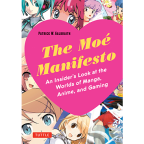Ouran High School Host Club
These Three Anime Genres Haven’t Evolved In Over 15 Years

It’s relatively common for new shows to stick to their genre’s formula for success. Not every show must be a groundbreaking work and in theory it only takes one unique show every couple of years to redefine an entire genre. This has been the case for most anime genres. However, not all genres have made equal strides and you’d be surprised to find how slowly some genres change. Here are three anime genres that haven’t evolved in over 15 years. Continue reading
Regarding the rereleases of Ouran High School Host Club and Simoun
Two weeks ago, on May 15, FUNimation rereleased Ouran High School Host Club on Blu-ray. I am writing this post to let you all know that the rerelease has the exact same content found in the old Blu-ray release. The only difference is that the rerelease is a budget release and doesn’t have that shiny pink box to go along with it. In other words, if you are interested in knowing more about this anime don’t hesitate to read our blu-ray review of Ouran High School Host Club.
Additionally, on June 12 Media Blasters will be rereleasing Simoun at a really awesome price. As in the case of the Ouran Blu-ray we were also able to confirm that the Simoun rerelease is a repackage of the old DVD version. As so the product you will be getting is identical to the one we already reviewed.
If you haven’t seen any of these great series yet now will be a good time to read the reviews and “adopt an anime”.
Join the club
Recent years have brought forth a slew of anime about school clubs. K-On! had the light music club, Haruhi had the SOS Brigade, MM! had the Second Voluntary Club, Haganai had the “make friends” club and so on. Most anime viewers in the West take these clubs with a grain of salt. Can such clubs exist in real life Japan or are they fictitious creations meant for the sole purpose of spicing up school life series for our enjoyment?
Well, the short answer is no, the SOS Brigade or the “make friends” club would never be allowed to exist in a real high school.
Why not? First of all, every club needs an advisor – a teacher which is responsible for the safety or the students involved in the club. He/She usually have background in the field of said club and can advise on club activities (hence the name advisor). To form a club in a Japanese high school there are certain rules that must be followed, and securing an advisor is on such rule. So even if there were those with the will to form a “host club”, they will have to find a teacher who is willing to be their advisor. That can be quite a challenging feat considering your club activities consist of entertaining girls, drinking tea and eating cake. In high school, most of the teachers are already involved in one or two permanent clubs (such as the kendo club or the music club) and will not take upon themselves a club which seems inappropriate or absurd.
Second, the number of clubs allowed to operate at the same time is predetermined by the each school, so even if you have an amazing idea for a club and did find a teacher who has the time and will to become your advisor, you might end up in a waiting list for club formation. This basically means your club will be on-hold until another club folds or is deemed inactive.
So yes, your average school anime uses clubs which in reality would not have been approved. There are exceptions of course: anime series usually do a good job when it comes to portraying sport clubs. Furthermore, sub categories of popular clubs (the light music club is a sub category of the music/instrumental club) do exist. And lastly, everything I wrote above does not hold in the case of private schools, in which exclusive clubs might be formed.
 A band inspired by K-On! The subtitles translate to:
A band inspired by K-On! The subtitles translate to:
“I watched the K-On! anime and it looked like good fun so I joined the club”
But wait, I said that the short answer to the question is no. The longer, yet simple, answer is indeed yes – most of these clubs can be formed in real life Japan. But not in high schools. They are made possible in a later time in life, when Japanese students don’t need to worry too much about tests and have exponentially more time on their hands for clubs – their university years. In the university clubs can be formed without the need for an advisor. Moreover university clubs can indulge in much longer and extravagant activities. For example a hiking club, while hard to be found in your average high school, is quite common in Japanese universities. I studied for my Master’s degree in Soka university (located in Tokyo’s Hachioji quarter) and we had tons of these clubs – the ski club, the hiking club, the onsen club (a club for onsen loving folks who want to try onsen in different parts of Japan), the electronic music club, you name it!
I know what you’re thinking: these are all normal clubs. Are there any crazy clubs à la anime series? Yet again the answer is a definitive yes. I was walking on campus one day when I spotted a sign board advertising several new clubs. Among these was “the chocolate lovers’ club”. The informative pamphlet specified it as a club “for chocolate lovers by chocolate lovers. Join us as we sample chocolate from all over Japan and go on expeditions in search of the perfect chocolate delicacy”. Alongside this club was a pamphlet advertising the gourmet club, which worked on a similar premise.
 Three attractive girls and one worthless guy decide to form a chocolate club in their local high
Three attractive girls and one worthless guy decide to form a chocolate club in their local high
school. Each of them works hard to create the perfect chocolate with the dream that one day
they can give it to their secret love as a present. In the final episode it turns out all the attractive
girls were madly in love with the worthless guy and give him their chocolate hearts. The series
will be called Chocolate Club Craze, but after the first episode everyone will refer to it as CCC.
I usually ate my lunch at about 3:30 pm, but one day I finished early and arrived at the cafeteria at around two o’clock. I was surprised to find that several people had connected some tables around the (seldom used) TV monitor and were watching a drama series. I walked in and curiously asked as to what they were doing. It turned out they were the self-proclaimed “drama watching club”. They formed the club to watch their regular drama series, which always aired on the same hour they took their lunch break. Creating the drama watching club didn’t garner them any special rights, except maybe the right the use the TV itself. It was more like an alliance of like-minded drama fans who spent the rest of their day studying at their respective faculties. And that’s exactly the difference between high school clubs and university clubs. Sure, you can join the Karate club even in the university and you will most likely be greeted by Karate experts with years of experience under their 3rd Dan Karate belt. But you can also try to indulge in your personal hobbies and create a less formal club of like-minded folks. The bottom line is this: clubs in Japan, just like any other country, are created to serve as a framework for like-minded people. Be it the Judo club, or the “we Love Plus club”.
Ouran High School Host Club Blu-ray Review
Finally! Watching 26 episodes for a weekly review is hard! There’s even a nice little video in the end! So I command you to go read the review even if you aren’t interested in the actual series! Just kidding
Have you noticed the upcoming review status bar on the right? I’ll be updating my review status there. That way the blog itself won’t be filled by “still watching X” or “expect the X review in two days” and so on.
The Future of the U.S. Anime Market
The start of a new year and the closure of Bandai USA have brought forth avid discussions about the future of anime in the U.S. Some forecasts are grimmer than others, and some are spot-on. So what should we expect from the U.S. anime market in the following years? I’ve decided to share my view of things with you.
Japanese companies will sell anime as direct-imports
That’s right. Just like Aniplex of America has been doing for the last two years, with great success if I may add, other Japanese companies will opt to remove the American distributors out of the equation and sell imports of their products directly in the U.S. These direct imports will have English subtitles and probably maintain all of the goodies presented in the original Japanese limited edition. They will also be available simultaneously with the Japanese release. In turn, the prices people will pay for these direct imports will correlate to the Japanese price, which means fans will be paying much more for their coveted series. Mind you, companies like TSRI have already jumped the gun and offer these direct-imports at a small discount which helps soften the blow.
Japanese companies will expect us to buy directly from Japan
Some Japanese companies will not even bother with exporting their series to the U.S., instead leaving it up to the fans to find a venue to buy from and import their English subtitled series. Some of these series will not be available to the U.S. audience in any other way, forcing those who truly cherish their anime to fork over considerable amounts of dollars yens.
The popularity of streaming will grow, but not by much
Streaming is good. It allows potential buyers to see a sample of the series that interests them before making the buy. Moreover streaming gives you access to more obscure licenses of series that never received physical copies or are out of print. It’s even cheaper than buying actual copies and it still supports the overall anime industry. The downside? There are so many streaming services, and most require you to sign up and pay a monthly fee. Netflix, PSN, XBL, Hulu, Crunchyroll, FUNico, ANN, Amazon Instant Video…so many services to decide from. What happens when you have three series you like, but each is on a different service?
Sadly, there is a more fundamental problem in streaming than just choosing which service to use: streaming is just not popular yet outside of the U.S. and so the revenues to extract from such a prospect don’t justify themselves. Streaming is almost unheard of in Japan. Why stream something at low quality when you can just subscribe to the TV channel that airs the thing? The exceptions that are streamed (like live performances on NicoNico) are usually shown for free or for a one-time fee. Streaming hasn’t taken Europe by storm either, because each streaming company has to ask the Japanese anime companies for permission to air their licensed series in Europe, and then receive permission to air the content from the TV authorities in the European country they wish to air the series at. In short, it’s a bureaucratic hell which will probably amount to nothing in the end. And streaming anime in the Middle East? Don’t make me laugh. Nor the Japanese companies nor the American distributors care for such a small market.
So in the end we are left with the U.S. alone. While there is certainly space for anime streaming services to grow within the U.S., these are the trickles of a stream that is already tapped.
U.S. distributors will become even more competitive
More limited editions and complete box sets, pre-order trinkets by the gallon, and attractive discount to whoever buys two or three series as a bundle. U.S. distributors know how to reel in the elusive fans and will not go down without a fight. This competitive nature will also reflect the shelf-life of certain series. A lot of series are bound to receive a very limited print run which will render those series out of print a couple of month following their official release. Why is such a policy good? It allows distributors to calculate the minimum demand for the product to assure that all copies will sell. For the anime companies, it is better to produce 2000 copies and completely sell out, than to release 10,000 and have only half of them sold. If the U.S. distributors are here to stay some compromises will have to be made. The dedicated fans will have to be more dedicated and buy the product on day one. They will in turn be compensated by being the proud owners of a very limited edition with prime boxes, the highest video and audio quality available and maybe a nice little collectible item.
This trend isn’t about to start, it’s already happening as we speak. Did you get your ludicrous over the top Ouran High School Host Club Blu-ray set? Or maybe the super limited edition of the Oreimo DVDs? Well, I hope you already bought them if you wanted them, because they were out of print a month or two after release.
U.S. distributors will export to reach a higher sales margin
Well, to be perfectly clear certain retailers in Japan will start stocking up on anime titles from FUNimation, Sentai and the like. Japan and the U.S. share the same Blu-ray region and anime on Blu-ray is much cheaper in the U.S. than it is in Japan. Hence reverse-imports offer the Japanese customers a nice cheap “American Edition”. Not only do they get their series for much cheaper, it also comes with an option for English subtitles and maybe even an English dub (ideal for those diligent Japanese students who want to perfect their English). In return those who buy reverse-imported copies stand to lose some of the extra content found in the original Japanese Blu-rays (a lot of extras don’t find their way into the U.S. Blu-rays and the Japanese couldn’t care less about English bloopers or commentary by the American cast). The U.S. Blu-rays also arrive fashionably late, which means reverse-importers need to have some patience in return for a cheaper price.
Think the idea of Japanese retailers stocking up on U.S. anime Blu-rays is far-fetched? Amazon Japan recently began to do just that. Series from FUNimation like Full Metal Panic, Angel Beats!, High School of the Dead, Samurai Girls and Claymore are already in stock there, and can be bought for a much cheaper price than their dated original Japanese releases. If the Japanese companies seek to take a chunk out of the U.S. Blu-ray market by directly exporting their products, why shouldn’t American companies take a chunk out of the Japanese Blu-ray market? The global anime market is a tough frontier, and the fiercer your rivals are the fiercer you’ll get.
We’ll see much much more “classic” releases
Remember those awesome anime series that brought upon the anime craze in the U.S. during the end of the 90s and the beginning of the millennium? Most of these series were targeted at a broad audience and focused on plot. Let’s face it, they don’t make these as much as they used to, and their impact on the western world has also weakened considerably. In fact people have been reciting for years that the moefication of anime, which has made anime so much more profitable in Japan, has been choking the western anime markets. The solution? Release those awesome classics again! Old fans could use updated retouched Blu-ray copies of their old VHS and DVDs, while new fans can discover the joy of anime that started it all in the west in the first place. I will be the first to admit that classics cannot support the U.S. anime market on their own (we need modern hits nonetheless), but they sure make up for all the unmarketable anime Japan keeps spawning up in recent years.




















